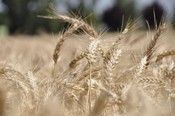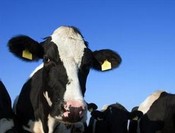 |
California WheatWhen one thinks of California agriculture, wheat usually does not come to mind. However, wheat is both a primary crop for many producers and a valuable rotational crop, helping to manage disease and improve the condition of the soil. Growing wheat is an important part of the economics of farming in California.

|
Wheat is grown throughout the state, from Imperial Valley in the south to the Klamath Basin in the north, and from the inland valleys to the coastal agricultural regions. Because of the state's large size and diversity of climates, wheat can be planted from October through February for "fall" sown wheat and April to May for "spring" sown wheat, depending on the region. Likewise, harvest can range from May to September, starting in the desert lowlands and finishing near the Oregon border. Due to the differences of our industry in comparison to other wheat producing areas, education of buyers is critical.
The most common units of measure for wheat marketed in California is Cwt. (hundredweights=100 lbs) or short tons (2,000 lbs) as compared to bushels (most other states of the U.S.) and metric tons (most of the rest of the world). Click here for a list of unit equivalents and conversion factors. Approximately 80-85% of the wheat acreage in California is on irrigable land. Average wheat yields for the state (2013-2017) were 2.23 tons/acre (~74 bushels) for common wheat and 2.92 tons/acre (~97 bushels) for Durum wheat, according to USDA statistics. Yields of 4-5 tons/acre are not uncommon.
Much of the average annual wheat production of 400,000 tons is used within the state for both human and animal consumption. California is a wheat deficit state, consuming more wheat than it grows. California mills collectively had the largest wheat milling capacity of all states in the country for 2016/17. Including their durum mills, California grinds approximately 1.9 - 2.0 million tons per year. Consequently, California mills also import wheat from other states to meet the excess demand.

|
California consistently ranks in the top five U.S. states for livestock products and has been the leading dairy state since 1993.* A fair percentage of California's wheat grain production is used to feed these animals, depending on the price of competing grains. And because of the sizable dairy industry, a large percentage of California's wheat crop never makes its way into the grain channels. From 2013-2017, an average of 58% of the common wheat planted in California was used for silage, green chop, forage, or hay. California still must import millions of tons of feed stuffs into the state to meet the needs of the livestock industry.
* Source: USDA. Livestock and livestock products include milk, beef cattle, eggs, sheep, turkeys, hogs and horses.

|
|
 |


